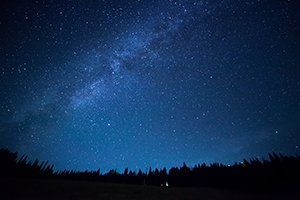The Blog
Dark Skies
April 24, 2024

Have you ever visited a major city where you’ve looked up and seen a murky sky without stars? What you’re seeing is light pollution, a serious problem in populated places, although experts claim that increased light pollution may impact even remote areas if initiatives to reduce it are not taken seriously.
Light pollution occurs when an excess of light is reflected into the atmosphere causing the sky to illuminate, potentially to the point that stars are invisible. It sadly has many consequences for ecosystems, climate, and human health. First, unnecessary light translates to wasted energy, and the amount of carbon emitted into the atmosphere will increase from creating this wasted energy. A study by the International Dark-Sky Association states, “The average house with poorly designed outdoor lighting wastes 0.5 kilowatt hours (kWh) per night… enough energy to power a 50-inch plasma TV for one hour or run one load in your dishwasher!”
Additionally, light pollution disrupts the Earth’s consistent shift from day to night, which all organisms rely on – nocturnal behavior is especially disrupted. Excessive light also causes extreme living conditions for plants to photosynthesize, threatening the foundation of entire ecosystems. Will organisms evolve like they always have? Or, has human impact potentially reached a point where our ecological changes are exceeding the rate of natural processes to adapt and evolve.
Finally, too much artificial light is unnatural for humans and can disrupt sleep and our health. While we can’t reverse what’s already been done, it is an easy fix to minimize human impact on light pollution moving forward. So, what’s the solution?
1. Ensure that lighting products are “Dark Sky Approved.”
2. Turn off lights when they’re not needed.
3. Contain and shield outside lights to shine downwards in concentration.
4. Use solid-state lighting, such as LED lights.
5. Use dimmers, timers, and motion sensors for outdoor lights.
Park City is taking the initiative to protect our dark skies. On January 1, 2021, Park City’s City Council adopted the No. 2021-05 Ordinance, requiring all existing outdoor lighting bulbs to be 3,000 degrees Kelvin by December 31, 2024, and new construction to produce less than 100,000 lumens (light) per acre. Additionally, the amendment states, “Low-lumen seasonal lights that do not cause light trespass or interfere with the reasonable use and enjoyment of property are permitted from November 1 – March 1.”
So let there be light! Just make sure that it’s sustainable and efficient for your sake, wildlife, healthy ecosystems, and our skies.
By Grason Rae, Sophomore at Park City High School